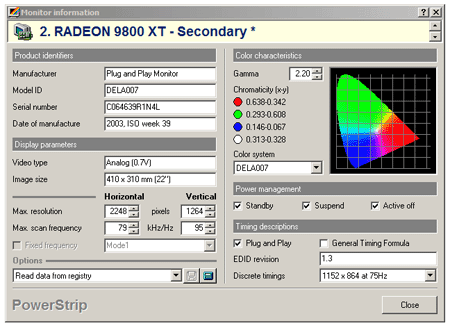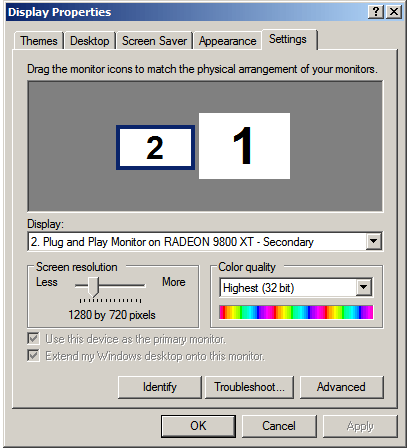Syntax Olevia 30" LCD: Cheap, Robust and Exceptional
by Kristopher Kubicki on June 30, 2004 12:00 AM EST- Posted in
- Displays
Construction
| Syntax Olevia LT-30 | |
| LCD | 30" UXGA LCD (Active Matrix) pixel pitch: 0.71mm Anti-glare coating Super MVA |
| Response Time | 25ms (TrTf) 16.6ms (Gray-to-Gray) |
| Contrast Ratio | 500:1 (Typical) |
| Compatibility | 1280x768 (Native) |
| Brightness | 500 cd/m2 |
| Dimensions (WxHxD) |
32" x 20.5" x 7" |
| Power | Working: 150W Standby/Off: 15W |
| Weight | 36 lbs |
| Warranty | 1 year parts and labor |
Although the LCD is out of the box ready to go with an HD-ready consumer appliance (any Component or DVI input should do), getting the LCD to function with our computer was significantly harder. There is no recognized driver for the monitor, so Windows XP was forced to use default display modes. Unfortunately, the HD 1280x720 resolution is not in the standard Windows profile. What complicates matters even further is that displaying unusual resolutions on the Olevia 30" forces the monitor into a Standby mode.
The solution in the end was to use PowerStrip to force the monitor to recognize a correct resolution. You may recall that we attempted to do a similar procedure when our Albatron LWX-30AMS would only display 1024x768 on the 1280x768 LCD panel (as we see later, the panels in these two displays are nearly identical). Unfortunately, the Albatron was limited by the signal processor on board; we could not utilize the monitor to its full potential because of the chipset. Fortunately, the Olevia display was much better thought out and, with enough patience, we were able to set up a correct display mode using a custom PowerStrip profile. Hopefully, in the future, Syntax will devise a better solution to this hack - ultimately, they should probably produce a driver for users who will use the LCD for presentations or enthusiast gaming.

Using PowerStrip to create a custom 1280x720 profile.
Click to enlarge.

Windows Properties
We were also able to use the same methodology to force the LT-30 into a 1280x768 display mode. The default Windows 1280x768 mode does not work correctly with the display; we needed to use PowerStrip to create a custom profile. Technically, our LCD is not the most optimal for viewing a 720p signal. Syntax uses a 1280x768 LCD panel, while a 720p HD signal uses 720 vertical lines in the signal. Therefore, 48 pixels are stretched vertically when we view a 720i/p signal. This is unfortunate, yet difficult to notice, as we show later in the analysis.
Fortunately for Syntax, the Olevia contained zero pixel defects. We were extremely pleased with the quality of the monitor as it arrived.
Our LT-30 came wall-mount capable, and removing the base to attach the wall mount brackets was extremely simple.










21 Comments
View All Comments
Swaid - Thursday, July 1, 2004 - link
K, got it...what I found from Digital Display Work Group (www.ddwg.org)
Dual Link
Dual Link DVI supports 2x165 MHz (2048x1536 at 60 Hz, 1920x1080 at 85 Hz). A dual link implementation utilizes all 24 of the available pins.
Single Link
Single Link DVI supports a maximum bandwidth of 165 MHz (1920x1080 at 60 Hz, 1280x1024 at 85Hz). A single link implementation utilizes 12 of the 24 available pins.
Souka - Thursday, July 1, 2004 - link
1280x768 native? Too low rez...my 19" is at that rez.TallCoolOne - Thursday, July 1, 2004 - link
Apple Dual-Link version of the nVidia 6800 is also exclusive to the PowerMac G5, so there's another $2000 or so needed to run the Apple 30"....I'm sure this technology will come to the PC _very_ soon, and will also require serious video card muscle to run at such high resolutions. For that reason, I don't see the same requirement on a Mac as a fair basis of criticism.
PrinceGaz - Thursday, July 1, 2004 - link
#14- the Apple display requires a Dual-Link DVI connection because Single-Link DVI isn't capable of a 2560x1600 resolution.Single-Link DVI only has 165MHz bandwidth which means a maximum resolution of 1920x1080 or 1600x1280 at a refresh-rate of 60hz. By using Dual-Link you get double the bandwidth which allows for double the resolution -- 2560x1600 is exactly double 1600x1280.
Neekotin - Thursday, July 1, 2004 - link
hey kris, is it really that good? ive been shopping for the dell 20' lately and now this.. your making my headache..Swaid - Thursday, July 1, 2004 - link
#15Awsome!
KristopherKubicki - Thursday, July 1, 2004 - link
Working on the Apple LCD and the Philips 1920x1080 LCD also.Kristopher
Swaid - Wednesday, June 30, 2004 - link
Has anyone seen reviews of the 30" Apple LCD display yet? The claimed 16ms response times sound very interesting for a 30" LCD...Actually it sounds like its 2 LCD panels put together since it needs a card capable of dual DVI output... Interesting!
Anandtech needs to review this ASAP! :D
WileCoyote - Wednesday, June 30, 2004 - link
Wow, it's a LCD review and the manufacturer isn't Samsung! Remember this moment, they don't come very often at Anandtech.Dagar - Wednesday, June 30, 2004 - link
Does the TV supply EDID to the PC via DVI?